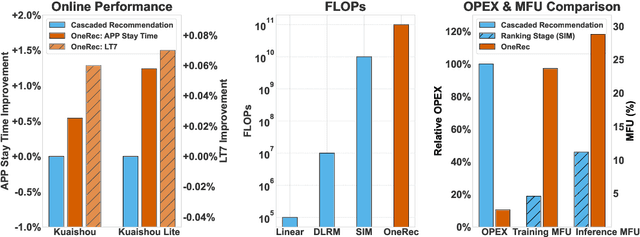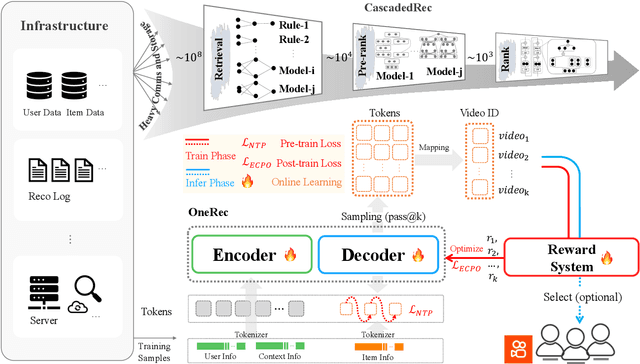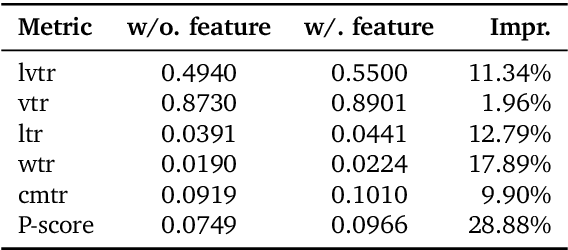Feng Jiang
GRAM-TDI: adaptive multimodal representation learning for drug target interaction prediction
Sep 26, 2025Abstract:Drug target interaction (DTI) prediction is a cornerstone of computational drug discovery, enabling rational design, repurposing, and mechanistic insights. While deep learning has advanced DTI modeling, existing approaches primarily rely on SMILES protein pairs and fail to exploit the rich multimodal information available for small molecules and proteins. We introduce GRAMDTI, a pretraining framework that integrates multimodal molecular and protein inputs into unified representations. GRAMDTI extends volume based contrastive learning to four modalities, capturing higher-order semantic alignment beyond conventional pairwise approaches. To handle modality informativeness, we propose adaptive modality dropout, dynamically regulating each modality's contribution during pre-training. Additionally, IC50 activity measurements, when available, are incorporated as weak supervision to ground representations in biologically meaningful interaction strengths. Experiments on four publicly available datasets demonstrate that GRAMDTI consistently outperforms state of the art baselines. Our results highlight the benefits of higher order multimodal alignment, adaptive modality utilization, and auxiliary supervision for robust and generalizable DTI prediction.
OneRec-V2 Technical Report
Aug 28, 2025Abstract:Recent breakthroughs in generative AI have transformed recommender systems through end-to-end generation. OneRec reformulates recommendation as an autoregressive generation task, achieving high Model FLOPs Utilization. While OneRec-V1 has shown significant empirical success in real-world deployment, two critical challenges hinder its scalability and performance: (1) inefficient computational allocation where 97.66% of resources are consumed by sequence encoding rather than generation, and (2) limitations in reinforcement learning relying solely on reward models. To address these challenges, we propose OneRec-V2, featuring: (1) Lazy Decoder-Only Architecture: Eliminates encoder bottlenecks, reducing total computation by 94% and training resources by 90%, enabling successful scaling to 8B parameters. (2) Preference Alignment with Real-World User Interactions: Incorporates Duration-Aware Reward Shaping and Adaptive Ratio Clipping to better align with user preferences using real-world feedback. Extensive A/B tests on Kuaishou demonstrate OneRec-V2's effectiveness, improving App Stay Time by 0.467%/0.741% while balancing multi-objective recommendations. This work advances generative recommendation scalability and alignment with real-world feedback, representing a step forward in the development of end-to-end recommender systems.
Ada-TransGNN: An Air Quality Prediction Model Based On Adaptive Graph Convolutional Networks
Aug 25, 2025Abstract:Accurate air quality prediction is becoming increasingly important in the environmental field. To address issues such as low prediction accuracy and slow real-time updates in existing models, which lead to lagging prediction results, we propose a Transformer-based spatiotemporal data prediction method (Ada-TransGNN) that integrates global spatial semantics and temporal behavior. The model constructs an efficient and collaborative spatiotemporal block set comprising a multi-head attention mechanism and a graph convolutional network to extract dynamically changing spatiotemporal dependency features from complex air quality monitoring data. Considering the interaction relationships between different monitoring points, we propose an adaptive graph structure learning module, which combines spatiotemporal dependency features in a data-driven manner to learn the optimal graph structure, thereby more accurately capturing the spatial relationships between monitoring points. Additionally, we design an auxiliary task learning module that enhances the decoding capability of temporal relationships by integrating spatial context information into the optimal graph structure representation, effectively improving the accuracy of prediction results. We conducted comprehensive evaluations on a benchmark dataset and a novel dataset (Mete-air). The results demonstrate that our model outperforms existing state-of-the-art prediction models in short-term and long-term predictions.
CMFDNet: Cross-Mamba and Feature Discovery Network for Polyp Segmentation
Aug 25, 2025Abstract:Automated colonic polyp segmentation is crucial for assisting doctors in screening of precancerous polyps and diagnosis of colorectal neoplasms. Although existing methods have achieved promising results, polyp segmentation remains hindered by the following limitations,including: (1) significant variation in polyp shapes and sizes, (2) indistinct boundaries between polyps and adjacent tissues, and (3) small-sized polyps are easily overlooked during the segmentation process. Driven by these practical difficulties, an innovative architecture, CMFDNet, is proposed with the CMD module, MSA module, and FD module. The CMD module, serving as an innovative decoder, introduces a cross-scanning method to reduce blurry boundaries. The MSA module adopts a multi-branch parallel structure to enhance the recognition ability for polyps with diverse geometries and scale distributions. The FD module establishes dependencies among all decoder features to alleviate the under-detection of polyps with small-scale features. Experimental results show that CMFDNet outperforms six SOTA methods used for comparison, especially on ETIS and ColonDB datasets, where mDice scores exceed the best SOTA method by 1.83% and 1.55%, respectively.
Segmenting and Understanding: Region-aware Semantic Attention for Fine-grained Image Quality Assessment with Large Language Models
Aug 11, 2025Abstract:No-reference image quality assessment (NR-IQA) aims to simulate the process of perceiving image quality aligned with subjective human perception. However, existing NR-IQA methods either focus on global representations that leads to limited insights into the semantically salient regions or employ a uniform weighting for region features that weakens the sensitivity to local quality variations. In this paper, we propose a fine-grained image quality assessment model, named RSFIQA, which integrates region-level distortion information to perceive multi-dimensional quality discrepancies. To enhance regional quality awareness, we first utilize the Segment Anything Model (SAM) to dynamically partition the input image into non-overlapping semantic regions. For each region, we teach a powerful Multi-modal Large Language Model (MLLM) to extract descriptive content and perceive multi-dimensional distortions, enabling a comprehensive understanding of both local semantics and quality degradations. To effectively leverage this information, we introduce Region-Aware Semantic Attention (RSA) mechanism, which generates a global attention map by aggregating fine-grained representations from local regions. In addition, RSFIQA is backbone-agnostic and can be seamlessly integrated into various deep neural network architectures. Extensive experiments demonstrate the robustness and effectiveness of the proposed method, which achieves competitive quality prediction performance across multiple benchmark datasets.
TRIDENT: Tri-Modal Molecular Representation Learning with Taxonomic Annotations and Local Correspondence
Jun 26, 2025Abstract:Molecular property prediction aims to learn representations that map chemical structures to functional properties. While multimodal learning has emerged as a powerful paradigm to learn molecular representations, prior works have largely overlooked textual and taxonomic information of molecules for representation learning. We introduce TRIDENT, a novel framework that integrates molecular SMILES, textual descriptions, and taxonomic functional annotations to learn rich molecular representations. To achieve this, we curate a comprehensive dataset of molecule-text pairs with structured, multi-level functional annotations. Instead of relying on conventional contrastive loss, TRIDENT employs a volume-based alignment objective to jointly align tri-modal features at the global level, enabling soft, geometry-aware alignment across modalities. Additionally, TRIDENT introduces a novel local alignment objective that captures detailed relationships between molecular substructures and their corresponding sub-textual descriptions. A momentum-based mechanism dynamically balances global and local alignment, enabling the model to learn both broad functional semantics and fine-grained structure-function mappings. TRIDENT achieves state-of-the-art performance on 11 downstream tasks, demonstrating the value of combining SMILES, textual, and taxonomic functional annotations for molecular property prediction.
OneRec Technical Report
Jun 16, 2025



Abstract:Recommender systems have been widely used in various large-scale user-oriented platforms for many years. However, compared to the rapid developments in the AI community, recommendation systems have not achieved a breakthrough in recent years. For instance, they still rely on a multi-stage cascaded architecture rather than an end-to-end approach, leading to computational fragmentation and optimization inconsistencies, and hindering the effective application of key breakthrough technologies from the AI community in recommendation scenarios. To address these issues, we propose OneRec, which reshapes the recommendation system through an end-to-end generative approach and achieves promising results. Firstly, we have enhanced the computational FLOPs of the current recommendation model by 10 $\times$ and have identified the scaling laws for recommendations within certain boundaries. Secondly, reinforcement learning techniques, previously difficult to apply for optimizing recommendations, show significant potential in this framework. Lastly, through infrastructure optimizations, we have achieved 23.7% and 28.8% Model FLOPs Utilization (MFU) on flagship GPUs during training and inference, respectively, aligning closely with the LLM community. This architecture significantly reduces communication and storage overhead, resulting in operating expense that is only 10.6% of traditional recommendation pipelines. Deployed in Kuaishou/Kuaishou Lite APP, it handles 25% of total queries per second, enhancing overall App Stay Time by 0.54% and 1.24%, respectively. Additionally, we have observed significant increases in metrics such as 7-day Lifetime, which is a crucial indicator of recommendation experience. We also provide practical lessons and insights derived from developing, optimizing, and maintaining a production-scale recommendation system with significant real-world impact.
EaqVLA: Encoding-aligned Quantization for Vision-Language-Action Models
May 27, 2025Abstract:With the development of Embodied Artificial intelligence, the end-to-end control policy such as Vision-Language-Action (VLA) model has become the mainstream. Existing VLA models faces expensive computing/storage cost, which need to be optimized. Quantization is considered as the most effective method which can not only reduce the memory cost but also achieve computation acceleration. However, we find the token alignment of VLA models hinders the application of existing quantization methods. To address this, we proposed an optimized framework called EaqVLA, which apply encoding-aligned quantization to VLA models. Specifically, we propose an complete analysis method to find the misalignment in various granularity. Based on the analysis results, we propose a mixed precision quantization with the awareness of encoding alignment. Experiments shows that the porposed EaqVLA achieves better quantization performance (with the minimal quantization loss for end-to-end action control and xxx times acceleration) than existing quantization methods.
Leveraging Gait Patterns as Biomarkers: An attention-guided Deep Multiple Instance Learning Network for Scoliosis Classification
Apr 04, 2025Abstract:Scoliosis is a spinal curvature disorder that is difficult to detect early and can compress the chest cavity, impacting respiratory function and cardiac health. Especially for adolescents, delayed detection and treatment result in worsening compression. Traditional scoliosis detection methods heavily rely on clinical expertise, and X-ray imaging poses radiation risks, limiting large-scale early screening. We propose an Attention-Guided Deep Multi-Instance Learning method (Gait-MIL) to effectively capture discriminative features from gait patterns, which is inspired by ScoNet-MT's pioneering use of gait patterns for scoliosis detection. We evaluate our method on the first large-scale dataset based on gait patterns for scoliosis classification. The results demonstrate that our study improves the performance of using gait as a biomarker for scoliosis detection, significantly enhances detection accuracy for the particularly challenging Neutral cases, where subtle indicators are often overlooked. Our Gait-MIL also performs robustly in imbalanced scenarios, making it a promising tool for large-scale scoliosis screening.
Beyond Object Categories: Multi-Attribute Reference Understanding for Visual Grounding
Mar 25, 2025



Abstract:Referring expression comprehension (REC) aims at achieving object localization based on natural language descriptions. However, existing REC approaches are constrained by object category descriptions and single-attribute intention descriptions, hindering their application in real-world scenarios. In natural human-robot interactions, users often express their desires through individual states and intentions, accompanied by guiding gestures, rather than detailed object descriptions. To address this challenge, we propose Multi-ref EC, a novel task framework that integrates state descriptions, derived intentions, and embodied gestures to locate target objects. We introduce the State-Intention-Gesture Attributes Reference (SIGAR) dataset, which combines state and intention expressions with embodied references. Through extensive experiments with various baseline models on SIGAR, we demonstrate that properly ordered multi-attribute references contribute to improved localization performance, revealing that single-attribute reference is insufficient for natural human-robot interaction scenarios. Our findings underscore the importance of multi-attribute reference expressions in advancing visual-language understanding.
 Add to Chrome
Add to Chrome Add to Firefox
Add to Firefox Add to Edge
Add to Edge